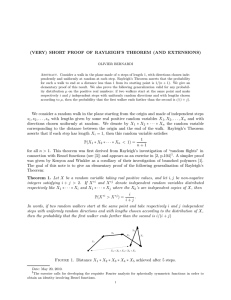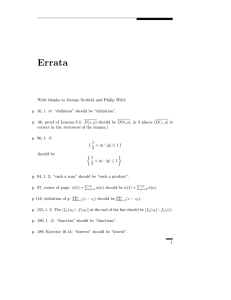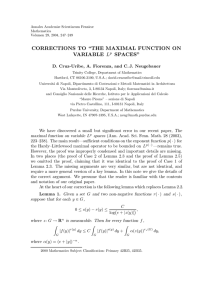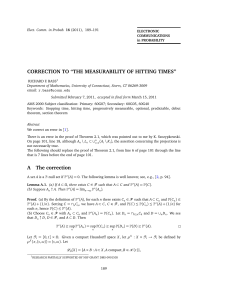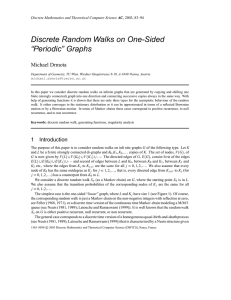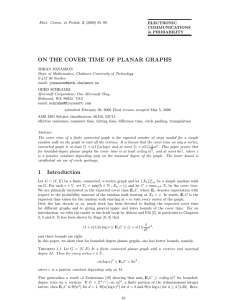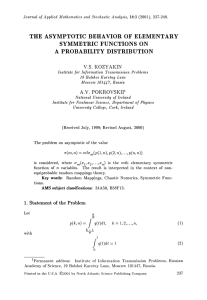A short proof of Rayleigh’s Theorem Microsoft Research, January 2011
advertisement
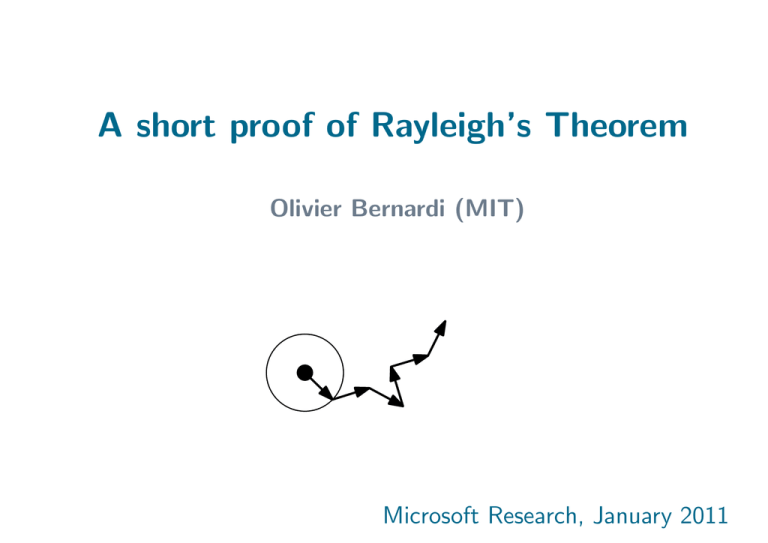
A short proof of Rayleigh’s Theorem Olivier Bernardi (MIT) Microsoft Research, January 2011 Spitzer’s walks in the plane Walks made of n unit steps. Direction of each step is uniformly random. Spitzer’s walks in the plane Walks made of n unit steps. Direction of each step is uniformly random. Theorem [Rayleigh] The probability for the walk to end at distance 1 less than 1 from the origin is . n+1 Spitzer’s walks in the plane Walks made of n steps of random lengths distributed as X. Direction of each step is uniformly random. X ∗6 X ∗4 Theorem [Rayleigh] The probability for the walk to end at distance 1 less than 1 from the origin is . n+1 Theorem [B.] For any positive random variable X, i ∗i ∗j P(X > X ) = . i+j Proof. Lemma. For any positive random variables A, B, C, P(A > B ∗ C) + P(B > A ∗ C) + P(C > A ∗ B) = 1 Proof. Lemma. For any positive random variables A, B, C, P(A > B ∗ C) + P(B > A ∗ C) + P(C > A ∗ B) = 1 Proof. We condition on A = a, B = b, C = c and prove: P(a > b ∗ c) + P(b > a ∗ c) + P(c > a ∗ b) = 1. • If a ≥ b + c or b ≥ a + c or c ≥ a + b, obvious. • Otherwise, consider the angles α, β, γ of the triangle. 2α One has P(a > b ∗ c) = etc. 2π α+β+γ Hence P(a > b ∗ c)+P(b > a ∗ c)+P(c > a ∗ b) = = 1. π a γ β b α c Proof. Lemma. For any positive random variables A, B, C, P(A > B ∗ C) + P(B > A ∗ C) + P(C > A ∗ B) = 1 Equivalently, P(A > B ∗ C) + P(B > A ∗ C) = P(A ∗ B > C). Let P (i, n) = P(X ∗i >X ∗(n−i) i ). We want to prove P (i, n) = . n Proof. Lemma. For any positive random variables A, B, C, P(A > B ∗ C) + P(B > A ∗ C) + P(C > A ∗ B) = 1 Equivalently, P(A > B ∗ C) + P(B > A ∗ C) = P(A ∗ B > C). Let P (i, n) = P(X ∗i >X ∗(n−i) i ). We want to prove P (i, n) = . n Apply the lemma to A = X ∗i , B = X ∗j , C = X ∗(n−i−j) . This gives P (i, n) + P (j, n) = P (i + j, n) whenever i + j ≤ n. Thus n P (1, n) = P (n, n) = 1. 1 i This gives P (1, n) = , and P (i, n) = i P (1, n) = . n n The end.




